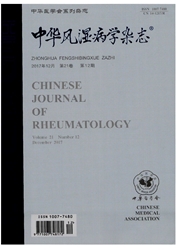

 中文摘要:
中文摘要:
目的 本研究旨在研究pSS患者的肺脏受累情况,并分析其影像学特点,探讨pSS患者发生肺脏受累的危险因素,为pSS患者肺脏受累的诊断及预后评估提供依据.方法 选取2003-2012年北京大学人民医院住院的1 341例SS患者,其中pSS患者853例,继发性SS(sSS)患者488例,分析患者的临床及影像学资料,以其中105例pSS肺脏受累患者为研究对象纳入病例组,选取同期(2008-2012年)84例不合并脏器受累的pSS患者作为对照组,根据美国胸科协会/欧洲呼吸协会(ATS/ERS)特发性间质性肺炎的分类,由2名经验丰富的放射科医师判断pSS肺脏受累的高分辨率CT(HRCT)异常类型、发生部位及肺叶受损面积评分.利用横断面研究探讨pSS患者肺脏受累患者HRCT的受损面积、分布部位及常见类型,利用病例对照分析及Logistic回归探讨肺脏受累危险因素.结果 SS患者肺脏受累发生率为21.70%(291/1341),其中19.34%(165/853) pSS和25.82%(126/488)sSS患者出现肺脏累及.高球蛋白血症及RF升高在该人群中明显,但抗SSA抗体、抗SSB抗体阳性率仅分别为52.5%和37.8%.pSS肺脏受累患者的HRCT分析示肺脏受累范围广泛,肺下叶受累比例高且肺叶受损面积大.常见HRCT异常类型为线样影(61例,93.8%)、磨玻璃样(57例,87.7%)、胸膜受累(42例,64.6%)、网格状样(41例63.1%)等.病例对照分析发现年龄≥60岁、C4低于正常、RF和ANA阳性的肺脏受累患者所占比例更高,然而,抗SSA阳性患者所占比例更低,差异均有统计学意义(x2=42.338,P<0.01;x2=3.681,P=0.05;x2=14.171,P<0.01;x2=10.507,P<0.01;x2=4.435,P=0.04).多元Logistic回归示年龄≥ 60岁(OR=7.73)及RF阳性(OR=4.43)为pSS患者发生肺脏受累的独立危险因素(均P<0.01).结论 肺脏受累是pSS患者的常见合并症,肺病变广泛且类型多样,下叶受累比例高且受损面积大.高龄及RF阳性为pSS肺脏受累的独立危
 英文摘要:
英文摘要:
Objective To evaluate the prevalence of lung involvement in primary Sj(o)gren's syndrome (pSS) patients,and analyze its radiological high-resolution computed tomography (HRCT) characteristics and risk factors for lung impairments.Methods A total of 1 341 hospitalized SS patients from 2003 to 2012 were retrospectively reviewed.The prevalence of pulmonary involvement was calculated.Among them,105 pSS patients (2008-2012) with lung complication and 84 without systemic damage were further explored.Demographic data,laboratory tests and arterial blood test (ABG) were obtained from medical charts.The HRCT scans were re-evaluated by two experienced chest radiologists.HRCT score of each lobe was assessed based on the percentage of affected lung parenchyma.The distribution and common types of lung involvement were evaluated by cross-section study.Case control study and Logistic regression were performed to explore the risk factors of lung involvement in pSS patients.Results Among the 1 341 hospitalized patients (853 with pSS and 488 with sSS),165 patients (19.34%) from pSS group and 126 patients (25.82%) from sSS group presented lung involvement.Hyperglobulinemia (IgG) and elevated RF were prominent,however,anti-SSA and anti-SSB were positive in only 52.5% and 37.8% patients,respectively.For the 36 patients who took ABG,20 presented with hypoxemia and 7 with type 1 respiratory failure.Lower lung lobes involvement was more frequent and more severe.The most common HRCT findings were linear opacities (61 cases,93.8%),ground-glass attenuation (57 cases,87.7%),pleural involvement (42 cases,64.6%) and reticular pattern (41 cases,63.1%).Compared with the control group,percentages of patients from age ≥ 60 year,low C4,elevated RF (OR=4.43)and ANA positivity were significantly higher (x2=42.338,P〈0.01;x2=3.681,P=0.05;x2=14.171,P〈0.01;x2=10.507,P〈0.01),whereas,those of anti-SSA positivity was significantly lower (x2=4.435,P=0.042).Advanced age (≥60 yea
 同期刊论文项目
同期刊论文项目
 同项目期刊论文
同项目期刊论文
 期刊信息
期刊信息
